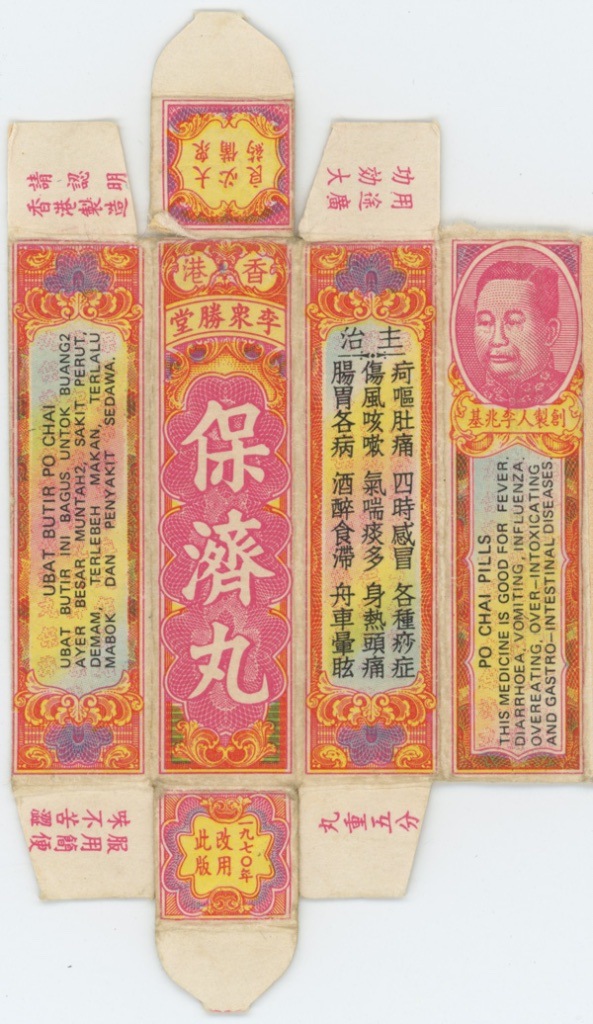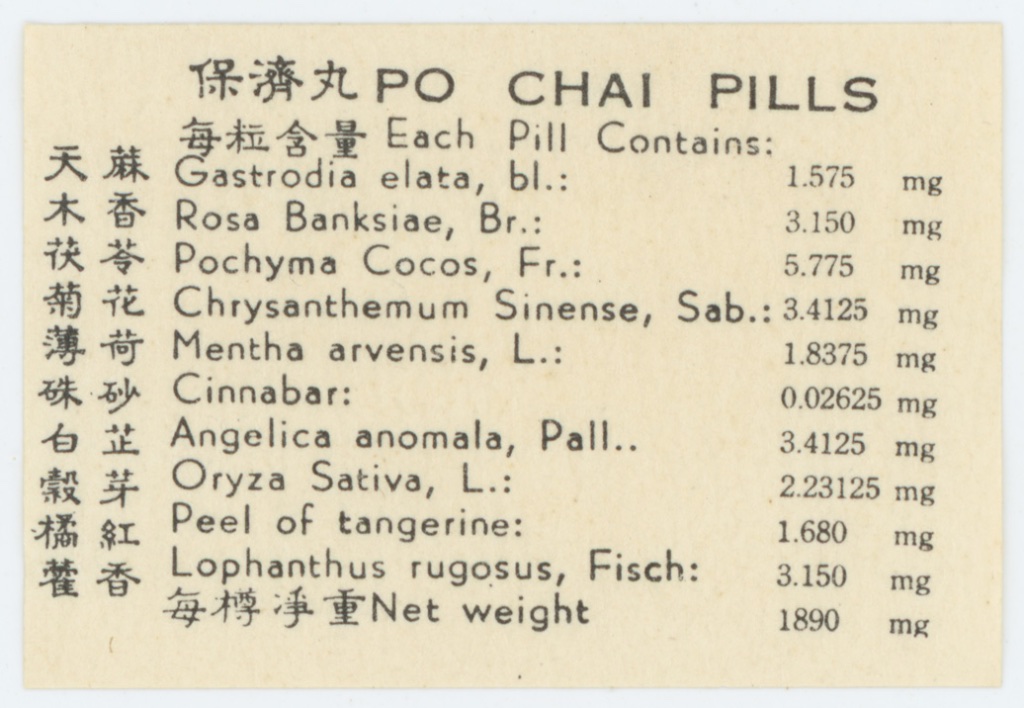Po Chai Pills
« previous post | next post »
Stephen Hart sent in this scan of a box containing medicine that he bought in Malaysia in 1972:
You can read the English explanation yourself to see what effects these marvelous little pills are claimed to have.
The corresponding Bahasa Malaysia panel on the box reads:
These medicinal pills are good for [treating] diarrhea, vomiting, stomach ailments, fever, over-indulgence in food, drunkenness, and excessive belching.
(courtesy of Geoff Wade)
And the Chinese says:
Main usages: vomiting, stomach pain, seasonal flus, all sorts of cholera and heat stroke, colds and coughs, asthma (shortness of breath), excessive sputum, fever and headache, various gastrointestinal diseases, drunkenness, indigestion, motion sickness.
In other words, they will cure what ails you.
The name Bǎojì wán 保濟丸 means "guaranteed relief pills".
There are no warnings on the package, though there should be. Although Malaysians swear by Po Chai Pills, they are said to contain mercury, and several times in recent years they have been forced to stop production in Singapore and Hong Kong because they were found to contain traces of phenolphthalein and sibutramine.
Here are the advertised contents:
If you are out partying on New Year's Eve, you might need the Po Chai Pills on New Year's Day!


Ethan said,
December 31, 2016 @ 8:08 pm
The mercury content is listed right there on the label:
Cinnabar: 0.02625 mg
KeithB said,
December 31, 2016 @ 9:22 pm
While it does not claim any healing properties, Dr. Bronner's soap bottle is fun to read:
https://www.drbronner.com
Victor Mair said,
December 31, 2016 @ 10:13 pm
@Ethan
Good catch!
"While all rocks contain some mercury, cinnabar (mercuric sulfide) contains the greatest amount of inorganic mercury (>80%)."
http://www.toxipedia.org/display/toxipedia/Mercury
For the role of cinnabar as an elixir in Chinese alchemy, see these articles:
https://en.wikipedia.org/wiki/Chinese_alchemy
https://en.wikipedia.org/wiki/Elixir_of_life
http://www.goldenelixir.com/jindan/jindan_intro.html
The ingestion of such elixirs, thought to promote longevity, led to the premature deaths of a number of emperors and other practitioners of the occult sciences.
John Rohsenow said,
January 1, 2017 @ 4:40 am
Mercury was used as a common treatment for the sexually transmitted disease syphilis. Mercury had been a popular 'cure' for syphilis since the 1400s, although we now regard it as too toxic to use.Dec 22, 2012.See:
Cures against syphilis through history:
http://www.academia.dk/Blog/syphilis/
Ken said,
January 1, 2017 @ 8:12 am
Perhaps the original phrasing was chosen to obey truth-in-labeling laws? :-)
Seriously – does this mean that Bahasa, like English, also uses "good for X" to mean "good for preventing X"?
Victor Mair said,
January 1, 2017 @ 5:23 pm
Here's some more information on mercury poisoning and its use in medicines:
https://en.wikipedia.org/wiki/Mercury_(element)#Medicine
https://en.wikipedia.org/wiki/Mercury(I)_chloride
https://en.wikipedia.org/wiki/Mercury_poisoning
For those who are interested in the great Ming Dynasty pharmacopoeist Li Shizhen says about elixir poisoning, I have a pdf with a couple of pages from Joseph Needham's Science and Civilisation in China.
Keith said,
January 1, 2017 @ 6:24 pm
@Ken,
That word "bahasa" just means "language" or "speech"; it grates on my nerves to hear or read the isolated word used as a shortcut in place of the full name of a language such as "bahasa melayu" or "bahasa jawa".
Aside from that little peeve, I think the construction is "bagus untok" + illness, meaning more or less "good for" or "good against" the symptoms…
Hilary Smith said,
January 2, 2017 @ 4:30 pm
A few years back there was a special issue of -Asian Medicine: Tradition and Modernity- devoted to the use of mercury in Ayurvedic and traditional Tibetan medicines: vol.8, no. 1 (2013). If anyone is interested but doesn't have access to the journal, let me know.
Dave Cragin said,
January 2, 2017 @ 5:55 pm
To add to John's comment, mercury was also common active ingredient in other drugs and personal care products in the US and Europe until the 1960s. Babies used to get “pink disease” (acrodynia) due to the use of mercurial-based diaper rash ointments and teething creams (calomel). In the 1920s, liquid mercury was also used as a supposed treatment for dietary disorders.
Many Americans likely recognize mercurochrome which was used a dermal antibiotic until 1998.
Until the late 1950s, organic mercurial diuretics were the also most effective diuretics available (used to treat high blood pressure). It’s not that physicians were ignorant of mercury poisoning. They actually knew much about mercury poisoning because they saw it first hand in their practices. However, the risk of heart disease from high blood pressure was judged as a greater risk than that from mercury.
This said, drugs and personal care products didn’t undergo the extensive animal and clinical studies that modern products do and as a result, risks/benefits weren't well characterized.
Mercury is definitely a material with a fascinating history.
Ken said,
January 2, 2017 @ 6:32 pm
@Keith: My apologies, I didn't look up the phrase. Thanks for the the additional information on the original.
Victor Mair said,
January 2, 2017 @ 8:21 pm
Someone I know is starting an article on elixir poisoning. I'm sure that it will be illuminating. From what he tells me, the history is incredible. In the 9th century Tang imperial order of succession, two father-son pairs died from elixirs: Xianzong (r. 805-820) and Muzong (r. 820-824), and Wuzong (r. 840-846) and Xuanzong (r. 847-859). In both cases, the newly enthroned emperor executed the Daoist alchemists who killed his father, and then later came to believe in other charlatans enough to consume their poisons. Go figure.
When the article is finished, I will call it to the attention of those who are interested.
Stephen Hart said,
January 2, 2017 @ 9:37 pm
After sending this scan to Victor, I found that there's a Wikipedia page for Po Chai pills, which appear to be still manufactured, in two countries, along with new dangerous ingredients:
https://en.wikipedia.org/wiki/Po_Chai_Pills
Keith said,
That word "bahasa" just means "language" or "speech"; it grates on my nerves to hear or read the isolated word used as a shortcut in place of the full name of a language such as "bahasa melayu" or "bahasa jawa".
At the time we were there, the governments of Malaysia and Indonesia were trying to unify the language variants, complete with ejaan baru, new spellings. I learned "Bahasa Malaysia" rather than "Malay," so I wrote that just out of habit. I don't know what the current situation is.
Jean-Michel said,
January 2, 2017 @ 11:52 pm
At one point I went to a Chinese medicine clinic (in China) for a minor but irritating condition that nothing else seemed to be helping. The doctor scribbled a couple of dozen ingredients (none of which I recognized) on a sheet of paper and told me to hand it to his assistant, who would then put it all together. She informed me that if I looked into the ingredients I would find several that were poisonous, but not to worry, because there were other ingredients that would "cancel it out." I took it anyway and it didn't hurt, though I don't think it helped either.
Chris C. said,
January 3, 2017 @ 12:39 am
All readers of Patrick O'Brian's Aubrey-Maturin books will know that mercury was the best thing available in the early 19th century for treating venereal diseases. I suppose the trick was to poison the disease before you poisoned the patient — somehow.
Those who favor wines from obscure California appellations might be familiar with the Cinnabar label, named for the mercury ore that was once mined extensively in the southern Santa Clara Valley from the most productive such mine in the US. Mercury was required for refining gold once upon a time, so this mine was absolutely essential for the California gold rush.
Stephen Hart said,
January 3, 2017 @ 1:09 am
And then, of course, there's the "Mad Hatter"
https://en.wikipedia.org/wiki/The_Hatter
Graeme said,
January 3, 2017 @ 4:17 am
42 years old. Must've been so efficacious a mere drop sufficed.
Jeff W said,
January 4, 2017 @ 7:13 pm
Stephen Hart
Well, Amazon sells them in the US and I’d be really surprised if you couldn’t get them easily in any Asian market in San Francisco or nearby. I’ve had them (although I think they’re pretty vile—they have a medicinal anise/licorice flavor).
Victor Mair
My Chinese-American friends swear by them also (or did*). It might be a generational thing for Chinese-Americans—maybe if you grew up in or around Guangdong or Hong Kong before a certain time, that’s just the thing you took, at least for digestive ailments.
*Twenty years ago, while we were in Thailand, my friend’s stomach was doing somersaults. She took her trusty bou2 zai3 jyun2 to absolutely no effect. I gave her some Imodium, which worked like a charm. As far as I know, she never looked back.
Andreas Johansson said,
January 5, 2017 @ 9:43 am
I'd be interested in the elixir-poisoning article.